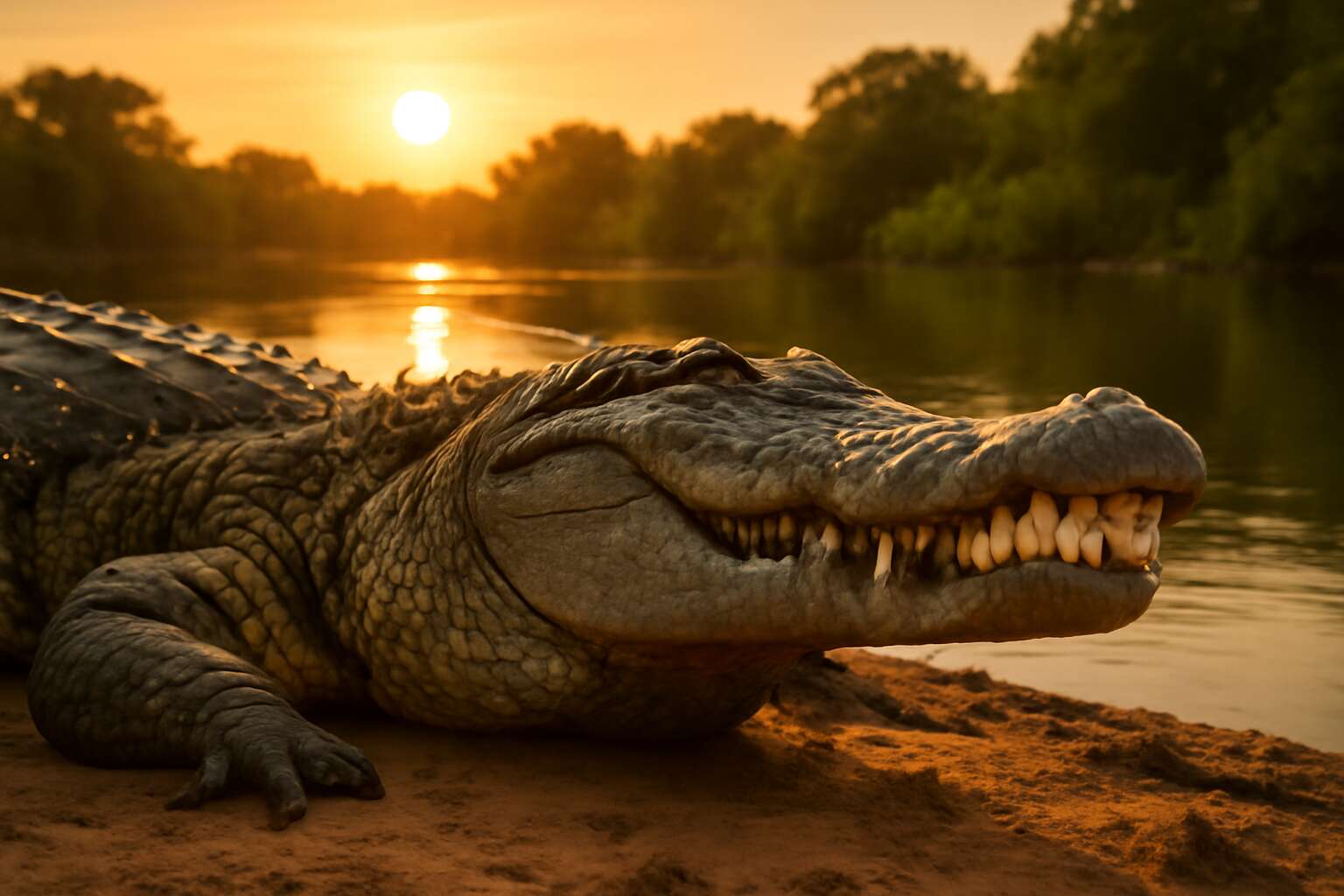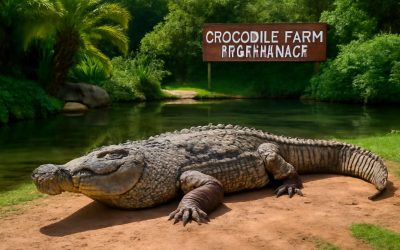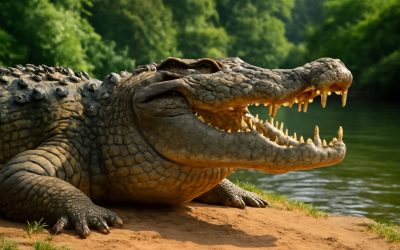Understanding Crocodiles: An Overview
Physical Characteristics of Crocodiles
When pondering whether a crocodile is amphibian or not, it’s easy to get caught in the web of misconceptions. These ancient predators, with their formidable presence, have fascinated humans for centuries. To truly understand their nature, it’s essential to explore their physical characteristics and evolutionary lineage. Crocodiles boast a robust, armored body, with a muscular tail that propels them through water like a living submarine. Their rough, scaly skin acts as a natural armor, offering protection against predators and the elements alike.
Unlike amphibians, crocodiles are true reptiles, belonging to the order Crocodylia. They lay leathery eggs and exhibit a development process entirely distinct from amphibian metamorphosis. Here’s a quick overview of their physical traits:
- Long, powerful jaws filled with sharp teeth
- Eyes positioned on the top of their head for stealthy hunting
- Webbed feet aiding in swift aquatic movement
This combination of traits solidifies their status as aquatic reptiles—not amphibians. The question of whether a crocodile is amphibian or not is answered clearly by their evolutionary roots, which firmly place them outside the amphibian family tree, making them the quintessential example of reptilian mastery in South Africa’s waters.
Habitat and Distribution
South Africa’s waterways teem with the silent, watchful presence of crocodiles—masters of their watery domain. These formidable reptiles have thrived for millions of years, their habitats spanning a diverse range of aquatic environments. When pondering whether a crocodile is amphibian or not, understanding their habitat and distribution reveals crucial clues about their true nature. Unlike amphibians that require moist environments for their life cycle, crocodiles are predominantly found in freshwater rivers, lakes, and estuarine regions. Their ability to adapt to both salt and fresh water has made them resilient across various South African ecosystems.
Crocodiles favor warm, tropical climates, and their distribution extends along the eastern coastlines of Africa, from the Limpopo River to the southern reaches of the continent. Their presence is often associated with areas where water bodies are abundant and stable—prime conditions for their survival.
- River systems such as the Limpopo and Orange Rivers are hotspots for crocodile activity.
- Wetlands, estuaries, and coastal lagoons serve as vital habitats that support their predatory lifestyle.
This widespread presence, combined with their reliance on aquatic environments, underscores a fundamental truth: crocodiles are true reptiles, not amphibians. Their exclusive adaptation to aquatic habitats, along with their evolutionary lineage, makes the question of whether a crocodile is amphibian or not a clear-cut answer—crocodiles are undeniably reptiles, perfectly suited to their watery realms in South Africa and beyond.
What Are Amphibians? Definition and Characteristics
Key Features of Amphibians
Amphibians are a fascinating group of animals that bridge the gap between aquatic and terrestrial life. They are characterized by their ability to live both in water and on land, which makes them unique among vertebrates. Typically, amphibians have smooth, moist skin that allows for gas exchange, a trait that sets them apart from many other animal groups. These creatures often have a biphasic life cycle, beginning as larvae in water before transforming into adults capable of surviving on land.
Understanding the key features of amphibians helps clarify whether a crocodile is amphibian or not. Amphibians usually possess three-chambered hearts, lay eggs in water, and undergo metamorphosis. They are sensitive to environmental changes, making them important indicators of ecological health. Unlike amphibians, crocodiles are reptiles with tough, scaly skin, and they do not undergo metamorphosis. So, when considering whether the crocodile is amphibian or not, the answer is clear: crocodiles are reptiles, not amphibians. This distinction is crucial in understanding their biological classification and habitat needs.
Lifecycle and Reproduction
Amphibians are creatures of transformation and mystique, embodying the delicate balance between water and land. Their defining trait lies in their lifecycle—an enchanting metamorphosis that begins beneath the surface of ponds and lakes. Typically, amphibians hatch as tadpoles, sporting gills and a tail, before gradually developing limbs and lungs in a process that captivates biologists and nature lovers alike. Their moist, permeable skin acts as a bridge between worlds, allowing for gas exchange and moisture absorption, which is vital for their survival.
Understanding what amphibians are reveals why the question “crocodile is amphibian or not” is often met with confusion. Unlike amphibians, crocodiles are true reptiles with tough, scaly skin that resists water loss—an adaptation suited for their predominantly terrestrial existence. They do not undergo metamorphosis. Instead, crocodiles have a straightforward reproductive process: laying eggs in nests and caring for their young with remarkable dedication. Their lifecycle is a testament to survival, but it firmly belongs to the reptilian realm, making it clear that crocodiles are not amphibians, but fascinating reptiles in their own right.
Common Amphibian Species
Amphibians are one of nature’s most captivating marvels, embodying a delicate dance between water and land. These creatures possess a unique blend of characteristics that set them apart from other vertebrates. Their defining trait lies in their ability to thrive in both aquatic and terrestrial environments, often making their life cycle a mesmerizing journey of transformation. Amphibians typically have moist, permeable skin that allows for gas exchange, a feature that underscores their dependence on a humid habitat. This skin acts as a vital bridge, facilitating respiration and moisture absorption, which are crucial for their survival.
Common amphibian species include frogs, toads, salamanders, and newts—each illustrating the diverse adaptations that have allowed amphibians to flourish across various ecosystems. These species often showcase vibrant colors and intricate patterns, highlighting their role in the delicate balance of their environment. When considering whether the crocodile is amphibian or not, it’s essential to recognize the profound differences that separate these groups. Crocodiles, with their tough, scaly skin and straightforward reproductive process, belong firmly within the reptilian realm, not among amphibians. Their lifecycle and physical traits reveal a creature deeply rooted in the reptile family, making it clear that crocodile is not amphibian but an iconic reptile in its own right.
Distinguishing Reptiles from Amphibians
Biological and Anatomical Differences
When pondering whether a crocodile is amphibian or not, it’s essential to understand the fundamental biological and anatomical distinctions that separate reptiles from amphibians. Despite their shared aquatic environments, these two classes of creatures are worlds apart in their evolutionary journey. Amphibians, such as frogs and salamanders, possess smooth, permeable skin that facilitates respiration, while crocodiles have tough, scaly skin designed to prevent water loss. This key difference alone often sparks the question: is a crocodile an amphibian or not?
Reptiles like crocodiles are primarily characterized by their leathery eggs and dry, resilient skin, which contrasts sharply with the gelatinous eggs and moist skin of amphibians. Additionally, the lifecycle of a crocodile is markedly different—most notably, their eggs hatch into miniature versions of adults, bypassing a larval stage that amphibians typically experience. This divergence in development emphasizes why the question “crocodile is amphibian or not” often leads to a clear answer: crocodiles are unequivocally reptiles.
Skin and Respiration
The distinction between reptiles and amphibians often blurs in the minds of many, yet it hinges on subtle but profound biological truths. When asking whether the crocodile is amphibian or not, it’s crucial to examine their skin and respiration. Amphibians, such as frogs and salamanders, possess moist, permeable skin that functions as a primary respiratory surface. This skin allows them to absorb oxygen directly from their environment, a trait vital for their survival in damp habitats. In stark contrast, crocodiles boast tough, scaly skin—an evolutionary adaptation designed to prevent water loss and protect against predators. Their skin acts as a formidable barrier, making respiration through the skin impossible.
Furthermore, the respiratory systems of these creatures underscore their differences. Amphibians typically breathe through their skin and lungs, adapting to a life that often involves both aquatic and terrestrial stages. Crocodiles, however, rely solely on their well-developed lungs, much like other reptiles. Their breathing is efficient and sustained, enabling long sojourns underwater without surfacing frequently. This divergence in skin and respiration is a telling sign that the question “crocodile is amphibian or not” often has a straightforward answer—crocodiles are unequivocally reptiles, not amphibians.
Understanding these distinctions deepens our appreciation of evolutionary complexity. It reminds us that despite superficial similarities in habitat, the biological fabric of these creatures is woven from very different threads. The resilience of crocodile skin and their specialized respiration systems are testaments to their ancient lineage, setting them apart from amphibians at every biological turn.
Eggs and Development
In the intricate web of evolutionary history, the distinction between reptiles and amphibians is often a point of fascination and confusion. When probing the question, “crocodile is amphibian or not,” it becomes essential to delve into the nuances of their reproductive strategies and developmental stages. Amphibians, renowned for their dual life, lay eggs in moist environments where their larvae undergo metamorphosis, transforming from water-bound creatures into terrestrial beings. Their eggs are typically encased in gelatinous, permeable membranes, facilitating gas exchange with the surrounding water or damp environment.
Contrastingly, crocodile eggs epitomize a different evolutionary path—hard-shelled, leathery, and highly resistant to desiccation. These eggs are laid on land, often in nests constructed from vegetation or sand, and require specific incubation conditions. The developmental process is direct; hatchlings emerge as miniature versions of their parents, bypassing any aquatic larval stage. This stark divergence in egg type and development underscores the fact that crocodiles are unequivocally reptiles, not amphibians. Such biological distinctions are vital for understanding why the question “crocodile is amphibian or not” can be answered with clarity—crocodiles belong firmly to the reptilian lineage.
Habitat Preferences
Habitat preferences often serve as the clearest visual cue in distinguishing reptiles from amphibians, and nowhere is this more striking than in the case of crocodiles. While amphibians tend to favor moist, lush environments—think wetlands, ponds, and damp forests—crocodiles have a penchant for more terrestrial, yet still aquatic, habitats. They prefer the warm, slow-moving waters of rivers, lakes, and estuaries, often basking on riverbanks under the African sun. Interestingly, their choice of habitat underscores their evolutionary divergence from amphibians, who are more at home in damp, shaded environments.
In fact, understanding the habitat preferences can clarify the answer to the question “crocodile is amphibian or not.” Unlike amphibians, which require moist conditions for their skin and reproductive processes, crocodiles are equipped with tough, leathery skin that minimizes water loss. This allows them to thrive in drier, land-adjacent environments, where they nest in sandy or vegetative areas. Their preference for land and water interfaces, combined with their eggs’ resistant shells—distinctly different from amphibian eggs—cements their status as true reptiles.
To truly appreciate these distinctions, it’s insightful to consider the following facts:
- Crocodiles often build nests on land, using vegetation and sand, highlighting their terrestrial inclinations.
- Amphibians, on the other hand, lay eggs in water, with larvae developing in aquatic environments before metamorphosing into terrestrial adults.
- Their respective habitat choices reflect their evolutionary adaptations—crocodiles with their robust, leathery skin, and amphibians with their permeable skin and reliance on moist habitats.
So, when pondering whether “crocodile is amphibian or not,” it becomes clear that habitat preference alone reveals a great deal. Crocodiles are unwaveringly reptiles, their environmental habits perfectly aligned with their evolutionary lineage, not the amphibian’s dual-life niche of moist and dry worlds. Their habitat choices are a vivid reminder that nature’s distinctions are often etched in the details—details that make all the difference in understanding the animal kingdom’s intricate tapestry.
Are Crocodiles Amphibians? Scientific Perspective
Taxonomic Classification of Crocodiles
In the murky depths of scientific inquiry, the question persists: Is a crocodile an amphibian or not? The answer is a haunting echo from the corridors of taxonomy, where these ancient predators are firmly rooted in the reptilian realm. Crocodiles, with their armored scales and powerful jaws, embody a lineage that predates the rise of mammals and birds alike. Their classification reveals much about their eerie, predatory nature—these creatures are classified within the class Reptilia, not Amphibia.
From a strict scientific perspective, the answer to crocodile is amphibian or not is clear: crocodiles are not amphibians. Instead, they belong to the order Crocodylia, a group characterized by their cold-blooded, semi-aquatic lifestyle and their ability to survive in some of the world’s most hostile environments. Unlike amphibians, which often display a dual life—part aquatic, part terrestrial—crocodiles are masters of the water and land, but their life cycle does not include the transformative metamorphosis typical of frogs or salamanders.
- They are true reptiles, with scaly skin and lungs adapted for breathing air.
- Their eggs are leathery and laid on land, unlike amphibian eggs which require water for development.
- They do not undergo a metamorphic stage like amphibians do, maintaining a consistent body plan throughout life.
This stark divergence in biological and anatomical features underscores why crocodiles, despite their amphibian-like habitat preferences, are undeniably not part of that enigmatic class. The dark, ancient lineage of crocodiles continues to fascinate, forever rooted in the reptilian shadows of history, rather than the amphibian’s fleeting, water-bound existence.
Comparative Analysis: Crocodiles vs Amphibians
When pondering whether the crocodile is amphibian or not, the answer is a resounding no. Despite their uncanny ability to lurk in murky waters and bask on riverbanks, crocodiles firmly belong in the reptilian camp. Scientific classification leaves no room for debate: these formidable predators are classed as reptiles, not amphibians. Unlike their amphibian cousins who juggle dual lives—sometimes frolicking in water, sometimes on land—crocodiles are all about mastery of both worlds, but without the metamorphic magic.
So, what makes them distinctly non-amphibian? For starters, crocodiles possess scaly, armored skin and lungs adapted for breathing air—features that scream “reptile” loud and clear. Their eggs are leathery and laid on dry land, contrasting sharply with amphibian eggs that require water for development. And, unlike frogs or salamanders, crocodiles do not undergo any dramatic bodily transformation during their lifecycle. They are the epitome of reptilian steadiness, not amphibian adaptability.
In essence, the question of whether the crocodile is amphibian or not can be answered with one simple fact: crocodiles are reptiles, not amphibians. Their evolutionary story is rooted in the ancient, dry-land-dwelling reptilian lineage—making them a fascinating, if somewhat intimidating, chapter in the book of natural history.
Expert and Scientific Opinions
When scrutinizing the question of whether a crocodile is amphibian or not, scientific consensus provides a decisive answer: crocodiles are unequivocally not amphibians. Despite their semi-aquatic tendencies and ability to linger in murky waters, these formidable creatures belong to the reptilian lineage, distinguished by their scaly skin and air-breathing lungs. Experts emphasize that the distinction hinges on fundamental biological differences—crocodiles have leathery eggs laid on dry land, and their development lacks the dramatic metamorphosis characteristic of amphibians.
Scientific opinions reinforce this clarity. Herpetologists and evolutionary biologists concur that crocodiles are part of the Crocodylia order, a direct descendant of ancient reptilian ancestors. To further illustrate, consider this:
- Their skin is heavily armored, unlike the smooth, permeable skin of amphibians.
- Their respiratory system is adapted for terrestrial breathing, not cutaneous respiration as seen in amphibians.
- Their lifecycle is steady and unaltered—no tadpole stage or aquatic larval phase exists.
In essence, the question of whether the crocodile is amphibian or not is answered with unwavering clarity by the scientific community. These reptiles exemplify evolutionary resilience, rooted firmly in terrestrial adaptation, and should never be mistaken for amphibians—creatures of dual lives and metamorphic magic.
Common Misconceptions About Crocodiles and Amphibians
Myths and Facts
Amid the swirling currents of misinformation, many still believe that crocodiles are amphibians. This misconception lingers despite clear scientific classifications. A common myth is that crocodiles share the same skin, respiration methods, or reproductive cycles as amphibians, which simply isn’t true. In reality, the question “crocodile is amphibian or not” has a straightforward answer: crocodiles are reptiles, not amphibians. They belong to a distinct taxonomic group characterized by their scaly skin, egg-laying habits on land, and fully developed lungs for breathing air.
Some people think that because both crocodiles and amphibians inhabit aquatic environments, they must be closely related. However, crocodiles are part of the archosaur lineage, which diverged from amphibians millions of years ago. This evolutionary separation means that a crocodile is not an amphibian, nor does it share the amphibian’s delicate skin or dual life stages. Recognizing these distinctions helps dispel prevalent myths and deepens our understanding of these formidable creatures.
Misclassification Causes
Many still grapple with the notion that crocodiles are amphibians, a misconception that persists despite overwhelming scientific evidence. The confusion often stems from their shared aquatic habitats, leading some to believe that crocodiles and amphibians are closely related. However, this is a fundamental misunderstanding of their biological classification. The question “crocodile is amphibian or not” is straightforward: crocodiles are unequivocally reptiles. They possess scaly skin, lay eggs on land, and breathe air through fully developed lungs—traits that set them apart from amphibians.
What fuels this myth? Sometimes it’s the appearance of their rough, textured skin or their ability to swim effortlessly in water, which can deceive the untrained eye. Yet, these features are common among various reptilian species, not amphibians. The evolutionary divergence is significant—crocodiles belong to the archosaur lineage, which split from amphibians millions of years ago. Recognizing these distinctions dispels the misconception that crocodile is amphibian or not and refocuses our understanding of these ancient, formidable creatures.
Why It Matters to Know the Difference
Ecological Roles
Understanding whether a crocodile is amphibian or not isn’t just a matter of academic curiosity; it profoundly influences our grasp of ecological harmony. In the grand theatre of nature, crocodiles are often mistaken for amphibians, a confusion that can have ripple effects on conservation efforts and ecological management. Clarifying this distinction ensures that efforts to protect these formidable creatures are based on accurate biological classifications, which in turn affects habitat preservation and biodiversity strategies.
Misclassification could lead to misguided policies, especially considering crocodiles’ vital role as top predators in aquatic ecosystems. Unlike amphibians, which are often indicators of environmental health, crocodiles are keystone species that help regulate prey populations and maintain ecological balance. Recognizing that a crocodile is not an amphibian underscores its status as a reptile—specifically, a member of the Crocodylidae family—highlighting its evolutionary adaptations for a semi-aquatic existence. This nuanced understanding shapes our approach to safeguarding their habitats and ensuring their survival amidst growing environmental challenges.
Conservation and Environmental Impact
Understanding whether a crocodile is amphibian or not transcends mere taxonomy; it’s a vital keystone in the edifice of ecological integrity. In South Africa’s diverse habitats, where crocodiles often share water bodies with amphibians, misclassification can obscure the true dynamics of these ecosystems. Recognizing that a crocodile is not an amphibian reshapes our perception of predator-prey relationships and habitat requirements. This distinction influences conservation strategies profoundly, ensuring efforts are directed towards protecting the right species in their authentic ecological roles.
Misunderstanding this classification can inadvertently lead to misguided policies that threaten biodiversity. For instance, amphibians like frogs serve as environmental indicators, whereas crocodiles act as apex predators—regulating prey populations and maintaining ecological balance. Clarifying whether a crocodile is amphibian or not helps safeguard their habitats effectively, especially as environmental pressures intensify. Accurate biological classification is not just academic; it is the foundation of sustainable conservation practices that preserve South Africa’s rich aquatic ecosystems.
Educational Importance
Understanding whether a crocodile is amphibian or not holds more weight than a mere taxonomy debate; it influences how we perceive and protect our delicate ecosystems. In South Africa, where water bodies teem with both crocodiles and amphibians, misclassification can lead to misguided conservation efforts. Knowing the real nature of these creatures helps clarify their unique roles in the environment, ensuring that policies reflect ecological truth rather than myth. After all, a crocodile’s place as an apex predator differs fundamentally from the amphibian’s role as a vital indicator species.
This distinction isn’t just academic trivia. It shapes public perception, conservation priorities, and habitat management. For example, amphibians like frogs are sensitive to environmental changes and often serve as ecological barometers, while crocodiles maintain balance by controlling prey populations. Recognizing that a crocodile is not an amphibian is essential for safeguarding biodiversity. It’s a reminder that clarity in biological classification ensures that our efforts to preserve South Africa’s rich aquatic ecosystems are rooted in fact, not fiction.




0 Comments